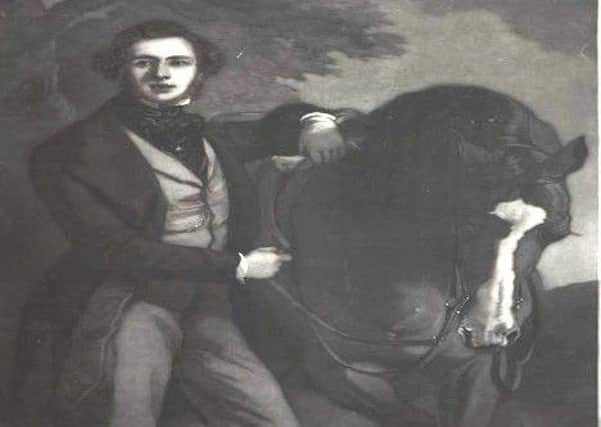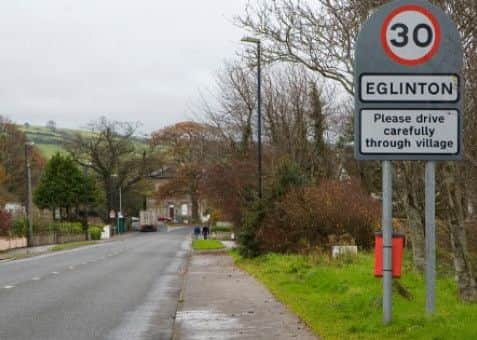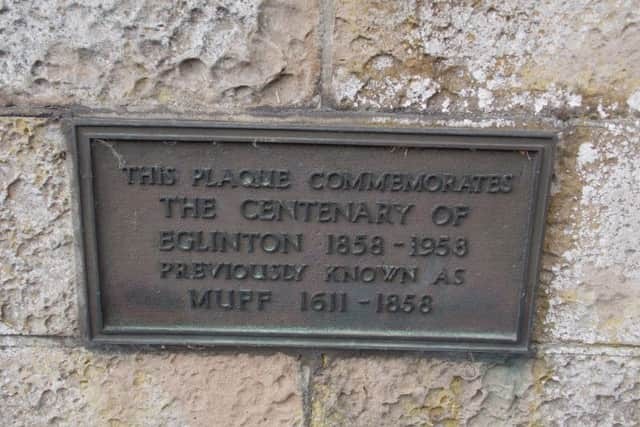Confusion, cannons and tragedy . . . how Muff Village became Eglinton


Now very much a thriving dormitory village, it is hard to believe that Eglinton, formerly called Muff, was once an agricultural showpiece.
Given that it was founded during the Plantation of Ulster and carefully husbanded by the London Grocers’ Company, it’s no surprise that a place with such associations would be an area of renowned agricultural importance.
Advertisement
Hide AdAdvertisement
Hide AdOf course, it’s fertile fields and the presence of a nationally renowned agricultural college in the area, made it an ideal venue for a demonstration of innovative farming machinery and practises in connection with the Agricultural Show of 1858.


One hundred years ago, no one approaching the village of Muff on August 19, 1858 could fail to notice the large banner displaying the words ‘Welcome Eglinton.’ This display and the assembled crowd along with another banner at Foyle Park emblazoned with the word ‘Eglinton,’ were in place to mark the visit of the Lord Lieutenant of Ireland, the Earl of Eglinton, Archibald William Montgomerie.
However, the banners also signified the strong plea from the residents to have the name of their village changed from that of Muff to Eglinton, in order to avoid confusion with the Donegal village of Muff, and to press that wish a petition was to be presented to His Excellency that day at the Templemoyle Agricultural School.
It was no coincidence then that His Excellency visited the city at the time of the North West Agricultural Society’s Show. His special train from Enniskillen arrived at the suitably decorated Waterside terminus on the evening of August 17 and was announced by a salute from guns on the City Walls.
Advertisement
Hide AdAdvertisement
Hide AdOn the platform, he was greeted by the Mayor of the city, the Lord Bishop and the member of parliament, as well as many other dignitaries.


Riding in a carriage with the Lord Bishop and escorted by mounted police, the whole procession made its way through the streets festooned with flags and specially constructed archways to the Corporation Hall in the city where he was officially welcomed.
According to the local Press, ‘the ardour of the thousands which had congregated to afford him a hearty welcome, did not appear in the slightest degree lessened by the torrents of rain which fell during the evening’.
On the morning of August 18, the first full day of his visit, the Londonderry Port and Harbour Commissioners, being keen to impress upon their distinguished visitor the needs and mercantile potential of the city, arranged an excursion along the River Foyle. No doubt the harbour must have presented a colourful spectacle then as all the shipping displayed their flags and, of course, the quay was already bustling as the agricultural show yard and its sheds came to life.
Advertisement
Hide AdAdvertisement
Hide AdThe fine weather, assembled crowds and music from the band on board his ship all added to the occasion as cannons saluted the departure of the steamer from the city wharf, but as the distinguished party steamed towards Boom Hall and Culmore they were unaware of the tragedy following the misfiring of one of the guns on the quayside. Along the routed more cannons were fired in salute as the party engaged in various toasts and, of course, an address was presented to His Excellency pressing for his support regarding the development of the port.
That evening back in Londonderry a banquet was held in the newly erected gas lit pavilion in Bishop Street where an attendance of over 800 was expected and at a reception afterwards held by the Lord Bishop of Derry guests were invited to meet the Lord Lieutenant.
Having acquainted himself with the mercantile potential of the city, the next day His Excellency devoted his time to viewing the agricultural developments in the area.
On the morning of August 19, he travelled by train to the station at Muff - soon to be renamed Eglinton - and then by horse drawn carriage into the village where the inhabitants greeted him as he made his way to the agricultural college in Templemoyle. There he saw some 40 pupils at work in the presence of teachers and an inspector of National Schools. On land nearby, he watched a demonstration of steam power where a traction engine and steam plough were the main attractions. The most important proceedings of the day, certainly as far as the Muff villagers were concerned, occurred at the Templemoyle School.
Advertisement
Hide AdAdvertisement
Hide AdThere, the local Anglican clergyman, Rev. John Conroy, presented to His Excellency the petition requesting that the village be named Eglinton.
“May it please you Excellency. We the undersigned, inhabitants of the town of Muff, Derry and its vicinity, beg leave to tender to your Excellency our most cordial welcome. Your visit to this part of the country gives us an opportunity of soliciting a favour which, if granted, will be highly appreciated. It will always be a distinguished honour if our town, instead of bearing the name ‘Muff,’ shall for the future bear the name ‘Eglinton.’
Many reasons might be given for desiring this change. One may be mentioned - the great inconvenience arising from our letters being very frequently missent to another post town in Donegal, bearing the same name, and also to Muff in the County of Limerick.”
In reply the Lord Lieutenant said he was flattered by the request and would be happy to think that near Derry a town called by his name would bring him to their remembrance when he was away.
Advertisement
Hide AdAdvertisement
Hide AdBefore leaving he made an entry in a book at the school referring to it as ‘Eglinton Agricultural Model School.’
Following his visit to the village, he then returned to the city where he visited a flower show at Gwyn’s Institution (Brooke Park) and his day concluded with his attendance at the Grand Ball held in the pavilion in Bishop Street. There the military provided an orchestra and the hundreds of guests, which included four Earls, two Marquises and six M.Ps, were entertained in surroundings draped with City and Royal Coats of Arms, retiring if they wished to a covered promenade and supper room. Friday was spent visiting his relation, Archdeacon Goold at his Rectory near Newtowncunningham, where he stayed overnight and on his return to the city he took leave of the local dignitaries and travelled to his next engagement by way of train to Coleraine.
Although there had been some deviation from the planned schedule of engagements, the whole visit passed off to the satisfaction of all.
His Excellency was able to visit his relation in Donegal and acquaint himself with the North West and the local dignitaries were able to highlight the needs of their city and port.
Advertisement
Hide AdAdvertisement
Hide AdAgricultural innovation and education were witnessed and the villagers at Muff had their request granted.
A sad note to the visit was the revelation in a small column of the local Press that two young men, Bradley and Hamilton, had been seriously injured in the cannon incident. Bradley lost limbs and an eye. Almost immediately a subscription fund was raised for them, but by the time the list of subscribers and their contributions appeared in the Press Bradley had died.
At a Coroner’s inquiry it was concluded that the two men had not taken proper steps to ensure the safe discharge of the gun,but it was happily reported that Hamilton was expected to recover from his injuries.
While the story of the tragedy takes a small space amidst the celebrations recorded in the local Press, the visit of the Lord Lieutenant to the village of Muff is marked by a centennial plaque. On those days which do not involve the customary commute, residents might care to walk the short distance from Main Street to the small bridge over the river opposite the Orange Hall to read this plaque erected on the anniversary of the historic visit, the day when a Lord Lieutenant agreed to give his name to the village.